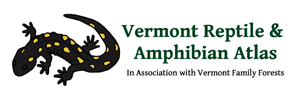Herp Update: Migration likely, Fundraiser, Reports – November 12, 2021
Amphibian Migration Tomorrow (Saturday Night)
Herpers, looking at the weather forecast for much of Vermont, it looks like tomorrow evening may generate some late-season amphibian migration. Since it is a Saturday and it is getting dark early, you could even take the kids out before dinner. It does not look like good conditions will last past 9 PM. Temperatures will be dropping and the rains ending fairly early. Lowland crossing locations like North Street in New Haven should see some movement.
Our Annual Fundraiser
Our annual fundraiser is off to a fast start with donations approaching $3,000 as of today. Still we have a long way to go to reach the $25,000 we hope to raise for next year’s work. If you have not donated already, please consider a donation. I have attached our fundraising letter with a summary of some of our accomplishments from the last field season and information on how to donate. You can also visit our GoFundMe site at: https://gofund.me/70b5be0e
Late Season Reports
We continue to receive reports of sightings this month. Sara E reported a Blue-spotted Salamander from up in Swanton. That area has lots of excellent habitat for that species and they continue to move late into the fall.
Many Eastern Red-backed Salamanders are still moving and near the surface. We have had November reports from Lincoln (Erin T), Hartford (Stephanie G), and Shaftsbury (Jackie S). My experience with Red-backs is that they will come to the surface in a prolonged and wet winter thaw but they are not known to be freeze tolerant, so they need to get below the frost line if they are to survive the colder days of the winter.
Some of the recent warm afternoons have generated movement in Common Gartersnakes with reports from Monkton (Steve Parren), Arlington (Evan R), and Hinesburg (Cindy S). I suspect all these snakes are staying fairly close to denning locations that can be accessed quickly each night.
At least a few Spotted Salamanders are still moving on some of the warm rainy nights we have been having. Ivy M reported one on the surface in Hubbardton just a few days ago. Sometimes these guys move as a result of wintering locations being disturbed by construction or predators, but I suspect this one was still moving to its overwintering location.
The recent warm afternoons have also motivated Spring Peepers to call from the leaves where they will overwinter. They are a freeze-tolerant species, so they don’t need to get below the frost line. However, their anti-freeze has its limits. If we loose the insulating snow and then get a cold spell, they may freeze and die.
November 9 was so warm and sunny I had to get out of the office. So, my assistant Kate Kelly and I took a quick trip over to Topsham to search seepage areas for Northern Dusky Salamanders. We needed to re-document their presence there since it have been over 25 years since they had been reported in Topsham. We only found one adult, but that was all we needed. Seepage areas are essentially geothermally heated all winter, so may amphibians use seepage areas to survive Vermont winters. They get cold, but they don’t freeze as long as the ground water continues to reach the surface.

